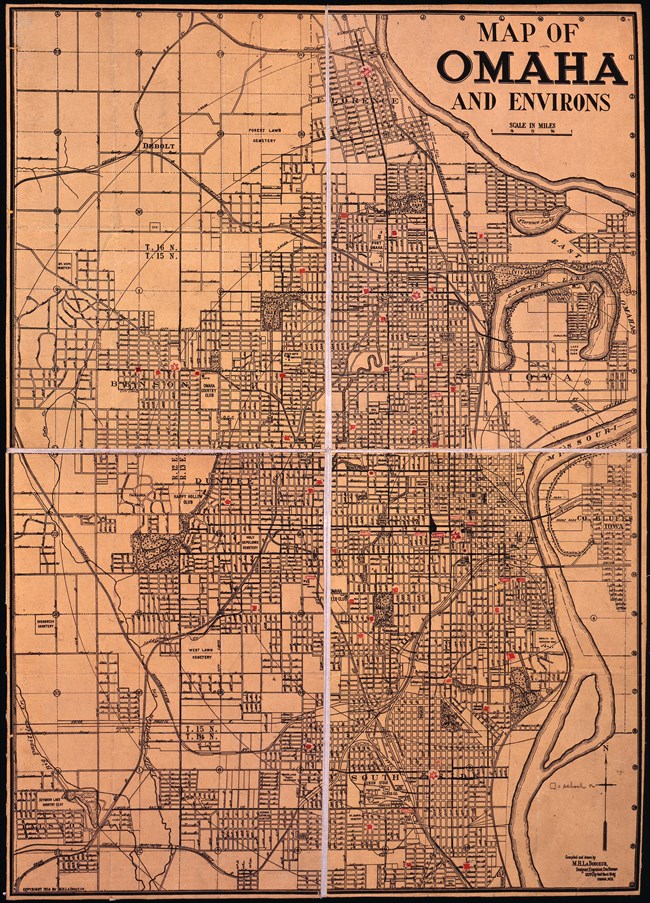Omaha's neighborhoods and apartment complexs reflect distinct eras and trends in residential living and architecture. To help you learn more about these areas, this page is divided into a historical overview, followed by a listing of historic properties that represent the city's residential development.
Overview

Landmarks Heritage Preservation Commission, City of Omaha
https://landmark.cityofomaha.org/article/3967-map
Downtown Omaha, a dense urban area adjacent to the Missouri River, is defined by its industrial and commercial history. The Old Market Historic District, a vestige of the city’s wholesaling industry, stands beside the towering headquarters buildings of Omaha’s oldest companies, including Union Pacific, Peter Kiewit Construction, and Mutual of Omaha.
Just north of downtown is the Near North Side, the first suburban enclave inhabited by White residents during the late nineteenth century. They gradually left the area during the first quarter of the twentieth century as African Americans moved in, new suburbs were developed, and streetcars and automobiles made commuting more feasible. Like most cities, racial tensions between White and Black residents contributed to this shift. The expansion of rail lines and industry made this area less attractive to families, apartment buildings sprouted up for factory workers and families unable to afford suburban living. Strehlow Terrace is one of multiple National Register of Historic Places apartment complexes in North Omaha representing the growing trend of apartment living in Omaha. Further south, in central Omaha, the twenty-two building Drake Court Historic District is Omaha’s last consistent street architecture, constructed by the Drake Brothers between 1916 and 1921.
Tracing its history back to 1870, the Village of Dundee was not fully settled until the early 1900s, eventually annexed by the City of Omaha in 1915. Developers advertised Dundee as a high-quality, more affordable living option to those seeking the quiet suburban life outside of the city’s center. The Dundee/Happy Hollow Historic District encompasses the mixed commercial-residential neighborhood of Dundee and the purely residential neighborhood of Happy Hollow. Single- and multiple-family dwellings in this district were designed by some of Omaha’s premier architects, including Thomas Kimball. Two years after annexing Dundee, the City of Omaha annexed Florence. The town was platted in 1855, the Bank of Florence was constructed the following year. Florence was considered Omaha’s rival until Omaha secured both the seat of the territorial capital and terminus of the transcontinental railroad. Its annexation is another example of Omaha’s growth to a major midwestern city.
Like many cities at the turn of the twentieth century, Omaha experienced suburbanization as the streetcar and automobile allowed people to move away from the city center to quiet suburbs while still retaining access to downtown areas. The Field Club and Gold Coast neighborhoods were established when newly laid streetcar routes would allow residents to move away from downtown to newly established subdivisions, bringing with them the Queen Anne and Victorian styles of the era. In some cases, construction of these neighborhoods continued until the post-World War II housing boom.
With the emergence of the automobile, development of suburbs changed as automobile culture arrived in the city. North Omaha’s Minne Lusa suburban development was platted in 1916.Within the Minne Lusa Historic District lie affordable single-family homes marketed toward Omaha’s growing middle class in the early twentieth century. For wealthy Omahans, the Fairacres Historic District was designed on City Beautiful ideals and, along with the Country Club Historic District, were some of the first Omaha neighborhoods designed around the automobile. The Indian Hills neighborhood is a mid-century suburban development that represents the continued growth of Omaha into the twentieth century.
At the turn of the twentieth century, Omaha’s population had swelled to over 100,000 people. Halfway through the century, Omaha’s status on the national and international stage was clearly defined. War production during World War II helped Omaha recover from the Great Depression, increasing both the city population and housing demand. The growth of Omaha during this area and the construction limitations placed on new construction at this time is exemplified by the Selby Apartments.
The neighborhoods of Omaha retain their historic character while still being part of the larger modern city. Father Flanagan’s Boys’ Home, a National Historic Landmark, built in the countryside west of Omaha is a unique example. For decades the separate Boys Town provided a bucolic rural community for children in need and now a separate town fully surrounded by a sprawling modern city, it very much retains it rural feeling. The many distinctive but interconnected areas together form the modern city of Omaha.
You can find the historic properties under this Story – along with others throughout Omaha – by visiting the Travel Omaha, NE Map.
Historic Neighborhoods and Dwellings of Omaha
Explore Omaha's Historic Stories
Last updated: April 6, 2023
